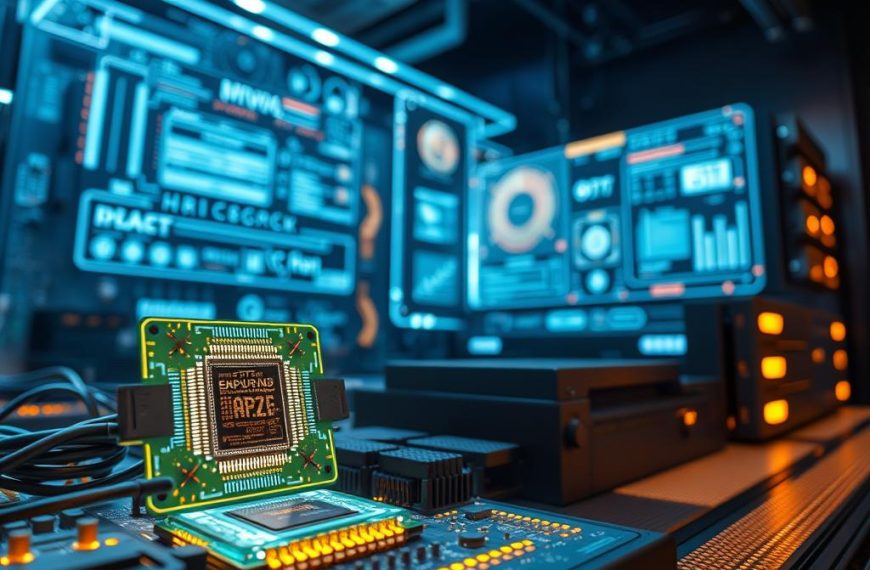Binary instructions form the basic language of computers. Machine code is the most fundamental communication between software and hardware. It turns complex programming ideas into pure computational language.
Machine code consists of binary instructions – sequences of 0s and 1s. These communicate directly with a computer’s central processing unit (CPU). Tiny signals power every digital interaction, from simple sums to complex AI algorithms.
Machine code operates at the most basic computational level. Each binary instruction is a specific command the CPU understands instantly. This enables rapid processing of digital information.
Binary instructions are the foundation of modern computing. They translate human-readable code into electrical signals. These signals drive technological innovation in every digital device.
Programmers rarely write machine code directly. Compilers change higher-level languages into precise binary instructions. This allows developers to focus on creating innovative solutions.
What is Machine Code in Computer Science
Machine code is the basic language of computers. It uses binary digits to enable direct communication between software and hardware. This system of 0s and 1s forms the foundation of digital interaction.
Machine code consists of numerical instructions made of 0s and 1s. These binary digits link software programs to the computer’s central processing unit (CPU). They serve as a vital communication pathway.
Binary Instructions and CPU Communication
CPU instructions in machine code are complex and specific to each architecture. Every processor family has its own set of machine language instructions. This creates a specialised communication protocol.
- Binary digits form the foundation of machine code
- Each instruction is a precise sequence of binary numbers
- CPU interprets these instructions directly
Machine Code vs High-Level Languages
Machine code operates at a lower level than high-level languages. High-level languages need translation into machine code for execution. This creates an essential step in program development.
Machine code: The raw, unfiltered language of computer hardware
The Role of Machine Code in Program Execution
Program execution relies on machine code’s ability to instruct computer hardware. It translates complex programming logic into simple binary instructions. This allows for rapid and precise computational processes.
- Converts high-level programming instructions
- Translates into CPU-readable binary format
- Executes computational tasks with maximum efficiency
The Evolution of Machine Programming
Machine programming has a captivating history in early computing. It’s a tale of remarkable innovations and groundbreaking discoveries. This journey spans from the earliest computational devices to modern programming paradigms.
The evolution of machine programming features several transformative moments. These key milestones have shaped the field we know today.
- 1843: Ada Lovelace created the first machine algorithm, laying the groundwork for future computational thinking
- 1936: Alan Turing published a foundational paper that revolutionised computer science
- 1949: Introduction of assembly language, providing a more human-readable alternative to raw machine code
Early computing relied on machine language. This consisted of direct binary instructions understood by computer processors. Such low-level programming required immense technical skill and precision.
| Year | Language | Significance |
|---|---|---|
| 1957 | FORTRAN | First high-level language for scientific computing |
| 1958 | LISP | Pioneering language for artificial intelligence research |
| 1959 | COBOL | Standard for business application programming |
The shift from machine language to assembly language was crucial. Assembly language introduced symbolic representations, making programming more accessible. It reduced the complexity of writing direct binary instructions.
Programming is not about what you know; it’s about what you can figure out. – Chris Pine
As technology advanced, programmers developed more sophisticated languages. These languages abstracted machine-level operations. Consequently, software development became more efficient and collaborative.
Understanding Machine Language Architecture
Machine language is the core way computers communicate internally. It’s how processors interpret and execute instructions using binary and hexadecimal codes. CPU architecture defines this intricate process.
Computer processors use unique instruction sets for precise calculations. These sets are the foundation of machine code. They turn complex programming ideas into executable binary patterns.
CPU Instruction Sets
Instruction sets bridge software and hardware. They contain specific commands that guide a processor’s actions.
- Arithmetic operations
- Logical computations
- Data transfer mechanisms
- Control flow management
Binary and Hexadecimal Representation
Machine code uses two main number systems. Binary representation uses 0s and 1s for basic coding. Hexadecimal code offers a more compact way to write complex instructions.
For example, the ASCII value for “A” is 01000001 in binary. This shows how letters are represented in computer language.
Memory and Register Operations
Memory operations are key to machine language architecture. Processors run instructions by changing data in registers. This allows for quick computations at the lowest level.
Machine language: Where silicon meets logic, transforming electrical signals into computational miracles.
The Process of Machine Code Execution
Machine code execution is the core process behind every computer operation. It’s a precise dance of electronic signals. These signals turn binary instructions into real computational results.
The instruction cycle has three crucial stages. These are fetch, decode, and execute.
- Fetch: The CPU retrieves instructions from computer memory
- Decode: The processor interprets the binary instructions
- Execute: The CPU performs the specific computational task
Modern processors handle complex code execution with remarkable efficiency. A typical 8086 microprocessor supports multiple instruction categories.
- Data transfer instructions
- Arithmetic operations
- Logical manipulations
- String processing
- Control transfer commands
In a pipelined instruction processor, executing machine instructions takes about 13 clock cycles. Each instruction involves precise stages like operand fetching and operation performance.
These stages show the intricate nature of CPU processing. The result write-back is also part of this process.
The beauty of machine code lies in its direct communication with the processor’s fundamental circuits.
Modern CPUs can stack over a billion transistors on a single chip. This enables incredibly complex computational capabilities. Yet, it maintains the elegant simplicity of the original instruction cycle.
From High-Level Code to Machine Language
Programming starts with writing code in human-readable languages. This code then goes through a complex journey. It transforms into machine-executable instructions via compilation, assemblers, and linkers.
The Compilation Pathway
Code compilation turns high-level programming languages into machine-readable instructions. Programmers write in languages like Python, Java, or C++. The code then goes through several stages.
These stages include source code analysis and syntax verification. They also involve intermediate code generation and machine code translation.
- Source code analysis
- Syntax verification
- Intermediate code generation
- Machine code translation
Assemblers and Linking
Assemblers turn assembly language into machine code. They change symbolic representations into binary instructions for CPUs. Linkers then join various compiled modules into one executable program.
| Stage | Function | Output |
|---|---|---|
| Compilation | Translate high-level code | Object files |
| Assembly | Convert assembly language | Machine instructions |
| Linking | Merge program modules | Executable program |
Code Optimisation Techniques
Code optimisation boosts the efficiency of machine language instructions. Developers use various strategies to improve performance. These include eliminating redundant computations and reducing memory access.
Other strategies involve restructuring algorithms and minimising instruction complexity.
- Eliminating redundant computations
- Reducing memory access
- Restructuring algorithms
- Minimising instruction complexity
Grasping these transformative processes helps programmers write better code. They can create efficient and streamlined programs that translate smoothly into machine instructions.
Machine Code in Modern Computing
Machine code drives technological innovation in modern computing. AI and machine code power sophisticated systems, changing how we use technology. Machine code fundamentals are vital for developing cutting-edge AI applications.
Hardware acceleration boosts computational efficiency. Optimised machine code allows processors to run complex algorithms at incredible speeds. Neural networks and reservoir computers use binary representations for intricate tasks.
The future of computing depends on advancing machine code development. New programming frameworks like SNP and DNP are expanding computational possibilities. These innovations promise better methods for handling complex maths and predictive modelling.
Machine code remains the essential language linking human instruction and computer execution. Researchers constantly explore ways to improve machine code’s efficiency. This makes it an exciting area in the ongoing digital revolution.














